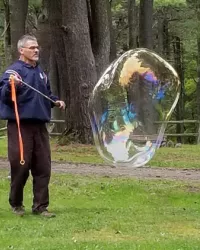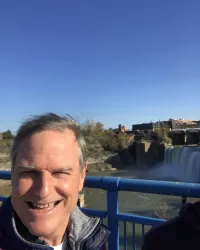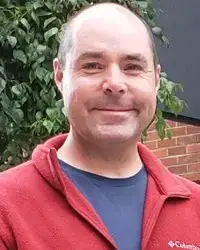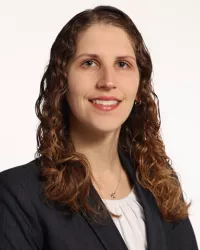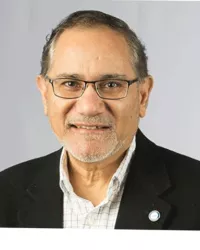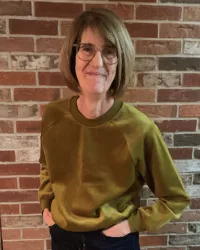The Physics and Astronomy Department includes six full-time faculty with a broad range of expertise. Faculty research interests include quantum field theory, supersymmetry, astrophysics, string theory, composite materials, electronics, engineering (including CAD/CAM/CAE applications), holography, lasers and photonics, magnetism and magnetic materials, microcomputing, optics, video analysis of motion, ionospheric and magnetospheric processes, globular clusters.
Allen Anderson
Science Technician
B24 Physical Science
Phone: 607-436-3197
Email: Allen.Anderson@oneonta.edu
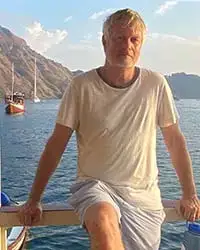
Dr. Michael Faux
Professor
Physical Science II, 127
Phone: 607-436-3145
Email: Michael.Faux@oneonta.edu
Dr. Faux is a theoretical and mathematical physicist. His work focuses on quandaries in quantum field theory, supersymmetry, supergravity, and string theory. Along with collaborator physicists and mathematicians, he has promulgated the use of novel graph-theoretic techniques to investigate the off-shell representation theory of supersymmetry in diverse dimensions. He has published papers on supersymmetry, supergravity, orbifold compactifications of string and M-theory, dualities, topological features of supersymmetric quantum mechanics, brane world scenarios, matrix models, extended conformal supergravity, and other topics in fundamental physics.
Dr. Faux earned his Ph.D. in theoretical physics from the University of Pennsylvania in 1994. He spent one year of his graduate studies in the theory division at CERN, in Geneva, Switzerland, and held postdoctoral research positions at Utrecht University in the Netherlands, Leuven University in Belgium, and at Humboldt University in Berlin, Germany, prior to spending three years as a VIGRE assistant professor at Columbia University and three years as a visiting assistant professor at Hobart and William Smith Colleges. He has been at SUNY Oneonta since Fall 2005.
In an earlier life, Dr. Faux earned a B.S. in Electrical Engineering from Penn State University in 1985, and spent a year and a half as a semiconductor development engineer at IBM in East Fishkill, NY, prior to returning to graduate school.
Dr. Faux's Publications
Dr. Faux's Curriculum Vitae
Dr. Paul A. French
Associate Professor
Physical Science II, 120
Phone: 607-436-3358
Email: Paul.French@oneonta.edu
Memberships:
- American Association of Physics Teachers
- American Physical Society
- American Society for Engineering Education
- Tau Beta Pi
Awards / Honors:
- American Society for Engineering Education, Section Outstanding Campus Representative, St. Lawrence Section, 2003
- Outstanding Advisor Award, 1999
- NSF Fellow, 1983 - 87
Professional Interests:
- Physics and engineering pedagogy
- Engineering Design
- Physics of electron devices
- Modeling of MOSFETs
General Interests:
Recent Publications/Presentations:
- "Interdisciplinary Project-Based Learning" (Ppt), P. French, Celebration of Teaching, SUNY Oneonta, Oneonta, NY, November 9, 2004
- "The Dinh Pa, A Multidisciplinary Learning Tool" (Ppt), P. French, J. Arrighi, T. Ploss, AAPT Symposium, Cornell University, Ithaca, NY, October 2, 2004
- How to Build a Dinh Pa (MSWord)
- “Digital Video in the Physics Curriculum,” CIT2002 (Continuing Forum on Instructional Technology) Conference, SUNY Oneonta, Oneonta, NY, May 29, 2002
Current Projects:
- Science Video Design
- Video-Based Measurements
Dr. Hugh A. Gallagher
Associate Professor
Physical Science, 124
Phone: 607-436-3177
Email: Hugh.Gallagher@oneonta.edu
I obtained my Ph.D. in Space Physics from Boston College in 1997. Under the direction of Dr. Robert Carovillano and Dr. Edward Weber, I used radar and optical measurements to investigate the electric circuitry of the aurora borealis. I continued this research on global scales as a post-doc at the Johns Hopkins Applied Physics Lab from 1997 to 1999. After a brief stint as a Visiting Professor at Bloomsburg University of Pennsylvania, I arrived at SUNY Oneonta in August, 2000.
Although I continue to be interested in the physical processes occurring in the near-Earth space plasmas of the ionosphere and magnetosphere, I have also conducted research with students on electrostatic phenomena and standing waves in enclosed bodies of water known as seiche.
A recent project (below) with two students investigated the feasibility of detecting seiche in Long Island Sound and Great South Bay.
More recently, we measured and modeled the characteristics of a seiche in a backyard pool. The results were presented at American Association of Physics Teachers Summer 2020 Meeting.
David Morell
STEM Instructor
Physical Science II, 126
Email: David.Morell@oneonta.edu
Dave is a 1992 graduate of the SUNY Oneonta Physics Department, earning his Bachelor’s degree in Physics with a minor in Mathematics. His graduate work includes a Master’s in Education, and a Master’s in Business. At SUNY Oneonta he was involved with research in Numerical Algorithms of Dense Stellar Structures under Dr. Merilan and Dr. Rhee. Since 1990 he has been involved in research, tutoring, and as an adjunct professor in both the Physics and Mathematics departments at SUNY Oneonta.
Dave has taught secondary Physics and Mathematics for many years, culminating in his creating the New Visions Engineering Program in 2011. He continues to provide the primary instruction for accelerated high school seniors at the Otsego Northern Catskills BOCES. The New Visions Program prepares students for the rigors of science at the collegiate level through college coursework, development of important professional skills, engaging hands-on experiences, and industry associations. Since the program’s inception a number of New Visions graduates have attended SUNY Oneonta majoring in Physics, Mathematics, Education, and Business.
Dave is a New York State Master Teacher and continually works to develop new curriculum and pedagogy to help students succeed. He loves to teach and spread the excitement of science and mathematics to everyone.
An Eagle Scout, Dave has been involved in Scouting his entire life, most recently as a Scout leader in Oneonta for the last twenty years. His other interests include reading, skating of all varieties, and chasing his children in all their adventures.
Dr. Joshua Nollenberg
Associate Professor, Department Chair
123 Physical Science
Phone: 607-436-2620
Email: Joshua.Nollenberg@oneonta.edu
Dr. Valerie Rapson
Assistant Professor
Physical Science 104
Phone: 607-436-3127
Email: Valerie.Rapson@Oneonta.edu
Dr. Rapson is an Astronomer and public outreach enthusiast who enjoys teaching people of all ages about science. A native of Rochester, NY, she earned her Ph.D. in Astrophysical Sciences and Technology at RIT where her research focused on the chemical composition and structure of planet-forming disks around nearby young stars. Her research interests include star and planet formation, exoplanets, and projects that can be done with small telescopes. She also enjoys giving public talks, visiting K-12 schools to teach astronomy, and participates in WAMC's Vox Pop radio show with Astronomer Bob Berman.
At SUNY Oneonta, Dr. Rapson teaches a variety of physics and astronomy courses. She also conducts exoplanet research with students utilizing telescopes at the College Camp Observatory, and designs and presents planetarium shows.
Prior to joining the faculty at Oneonta, Dr. Rapson was the director of the Dudley Observatory in Albany, NY. There, she designed and taught astronomy education programs for children and adults, operated the Suites-Bueche planetarium, and oversaw the construction of roll-top roof observatory with a 14inch telescope. She is a National Astronomy Ambassador and was awarded the 2018 Emerging Leader Award by Girls Inc. of the Greater Capital Region for being a role model to young women who aspire to become scientists.
Emeritus Faculty
Dr. Sunil Labroo
Professor
Physical Science #127
Phone: 607-436-3323
Email: Sunil.Labroo@oneonta.edu
Degree: Ph.D.
Graduated From: Southern Illinois University
Year: 1991
Year of Joining SUNY Oneonta: 1998
Memberships:
- American Physical Society
- American Association of Physics Teachers
- Sigma Xi: The Scientific Research Society
Awards / Honors:
- Fulbright Lecturing Award, 2004
- Innovative Uses of Technology Award, 2002
- Sigma Pi Sigma
- Honorary Citizen of Carbondale, IL
Professional Interests:
- Magnetism of rare-earth based intermetallics and magnetic phase transitions
- High-temperature superconductors
- Thin-film materials and processes
- Material characterization using electrical transport, thermal and magnetic measurements
- Process control and data acquisition with PC's
- Carbon dioxide lasers and laser-induced photochemistry
General Interests:
- Hiking, nature, travel, world cultures, music.
Recent Publications:
- "Investigation of the High-Temperature Magnetic Phase in (Tb1-xNdx)Mn2Ge2", S. Labroo, T. Gibson, M. Oakes, N. Ali & S. Saha, Bull. Amer. Phys. Soc., Vol. 45, p. 91, (2000).
- "Investigation of the High Temperature Magnetic Phases in the Ternary System Sm(Mn1-xCrx)2Ge2", S. Labroo, N. Ali, S. Saha & D. Zych, Bull. Amer. Phys. Soc., Vol. 44, p. 1128, (1999).
- "Magnetic Transitions in Tb0.7Nd0.3Mn2Ge2 Compound", S. Saha, N. Ali, S. Labroo & D. Zych, J. Appl. Phys., Vol. 83, p.6974, (1998).
- "Mechanisms of Magnetic Separation of Fine Y - Ba - Cu - O Powders in a Gas Fluidized Bed", S. Labroo, J. Y. Park, R. J. Kearney & W. J. Yeh, Cryogenics, Vol. 33, p. 1063, (1993).
- "Power Law Behavior of the Magnetization Curves of YBCO Superconductors", W. J. Yeh, Z. Q. Yu, S. Labroo & J. Y. Park, Physica C, Vol. 194, p. 141, (1992).
Staff
Carol Conroe
Administrative Assistant I
127 Physical Science Building
Email: Carol.Conroe@oneonta.edu
